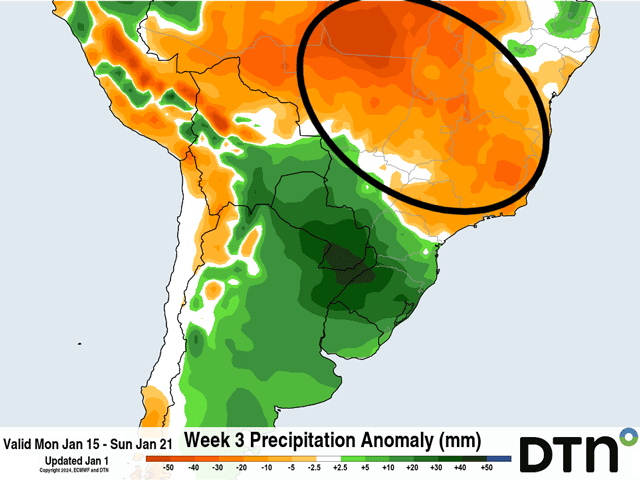South America Calling
Central Brazil Forecast Has Another Dry Week in January, But Will it Matter for Crop?
Heavy rain has set up across a good portion of central Brazil, easing stress during a critical period for filling soybeans. But a drier stretch of weather is forecast for later in the month.
Will this dry stretch return some concern to the soybean crop? And will the recent and forecast rain have a positive impact on soybean production in central Brazil?
Since the long New Year's Day weekend, heavy rain has been consistently concentrated in some of the driest areas of the region from Mato Grosso to Minas Gerais north through Tocantins and Bahia. The five-state region, which includes Goias as well, accounts for roughly half of all production in the world's largest production country for soybeans.
P[L1] D[0x0] M[300x250] OOP[F] ADUNIT[] T[]
Heavy rain has added up to an average of 50-75 millimeters (about 2-3 inches) in the first three days of January across wide areas of the region. Rain came before this period as well. Some areas have underperformed and others have overperformed, but the average is a solid week or two's-worth of rainfall during the heart of the wet season in a few short days.
The short-term forecast has this heavy rainfall continuing through much of the next week. Through at least Jan. 12, both the European ECMWF and American GFS models suggest the train of heavy rainfall continues in this region. Amounts near or over 100 mm (about 4 inches) are common throughout that time. But afterward, both models start to dry out the region, starting first in Mato Grosso, the country's largest producer of soybeans and the state arguably hit hardest by hot and dry conditions this season. Models differ on whether that will extend all the way to Bahia and Minas Gerais or be more of an interior issue. However, models suggest around 30 mm or less (about 1.2 inches) for the following week. Models do see a return to normal or even above-normal rainfall for the end of January and early February.
When the rain does not show up, the heat intensifies with daytimes highs approaching or exceeding 40 Celsius (104 Fahrenheit), quickly using the built-up soil moisture of the previous two weeks as beans continue to fill their pods. Will soybeans be able to withstand the stress if it comes? And will thoughts about production issues crop back up again?
Even with a wet January forecast in mid-December, markets only seemed to react when the rain finally showed up. (https://www.dtnpf.com/…) Will they do the same once the dryness is in sight? It's hard to tell. Throw in the USDA World Agricultural Supply and Demand Estimates (WASDE) report due out Jan. 12; USDA is expected to lower production in Brazil and the transition to a dry forecast is expected, and markets could make for some interesting jumps and dives during the next two weeks.
Of course, the wet forecast now is good for building soil moisture for the current soybean crop, but also for the coming second-season (safrinha) corn crop. Due to the lack of rainfall throughout the season, soil moisture in central Brazil is very low for this time of year. Producers in Brazil count on a large reserve of soil moisture building up during the wet season to sustain a corn crop past its pollination period after the wet season rains end.
If the week of dry weather moves in again, it could turn back the amount of moisture available for safrinha corn later in the season. The bulk of the soybean crop matures at the end of January and February and safrinha corn is planted immediately afterward. Should further disruption occur to the wet season rains, weather for the safrinha corn season will quickly pick up interest for producers and commodity markets alike.
To find more international weather conditions and your local forecast from DTN, visit https://www.dtnpf.com/….
John Baranick can be reached at john.baranick@dtn.com.
(c) Copyright 2024 DTN, LLC. All rights reserved.






Comments
To comment, please Log In or Join our Community .